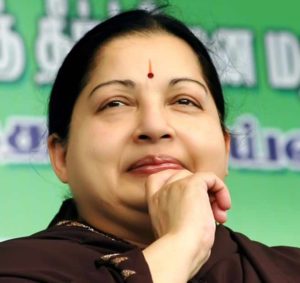Shining Star
Indian mainstream media (English/Hindi) sees Selvi J. Jayalalitha as an educated and elegant Southern Indian politician. She is seen as a shining star among the non Hindi speaking political crowd of southern India. She is also generally viewed positively by Social Media elite.
One of the very few interviews she gave to Media was a English interview to Simi Garewal. This was one of the best showcases of her elegance to the rest of the world.
Beneath the Cloak
Jaya was known popularly asAmma and many outside the state of Tamil Nadu believed she was a motherly figure. The reality can be little different based on her past adventures. Inside the green cloak of kindness was an angry and insecure woman. Jayalalitha’s passion and anger was notorious in her first five year term as Chief Minister (1991-1996). This was the same time I developed a penchant for reading Tamil weekly magazines. The articles on these political magazines were far more intriguing to me than any movie.
The stories of Jaya’s tolerance for any criticism were quite well known for most of the local population. The violence faced by Nakeeran’s office and Acid attack on Chandralekha are still fresh in memory. During the infamous years Jaya’s brigade went against KM Vijayan a lawyer who dared to file a case against Jaya’s Govt and got a stay against 69% reservation in Tamil Nadu. There were judges and Bureaucrats who were attacked for questioning the Chief Minister’s wishes.
This article from India Today’s 1994 edition sums up the history very well, sometimes Im surprised how so much of Jaya’s history can ignored.
Rule by Sister Sasi
Not much is known about the kind of the personal relationship between Sasikala and Jayalalitha, but everyone is sure about the outcome. Many believe most of the corruption attributed to AIADMK and Jaya are direct results of Sasikala and her Mannarkudi family. While Jayalalitha did not have immediate and extended family, this void was filled by Sasikala’s family and helped her amass the wealth. It culminated in 1996 marriage of Jayalalitha’s adopted son (he was a relative of Sasikala). The adoption was planned and played by Sasi’s family to establish a legal relationship with heirless Jaya.
The fall and rise
The Step-Son marriage was instrumental in showcasing Jaya’s corruption and ultimate loss of power to DMK. But with short term memory and aided by Corruption in DMK Government and Populist schemes, Jaya was back in power after next 5 years. While the power of Mannarkudi gang of Sasikala started asserting more power within the party, it also lead to suspicion by Jayalalitha who banned several members of Sasikala’s family and fired several AIADMK members who were seen close to Natarajan (Sasi’s husband) and Venkatesh (Relative of Sasi). Despite all this Sasikala’s family dominated AIADMK and all of the party’s assets.
We will continue to look into Jayalalitha’s life and per political legacy in next few chapters. Please add your comments and opinions. If I have some incorrect information, I will be glad to correct it.
